Abralia
Richard E. Young and Kotaro Tsuchiya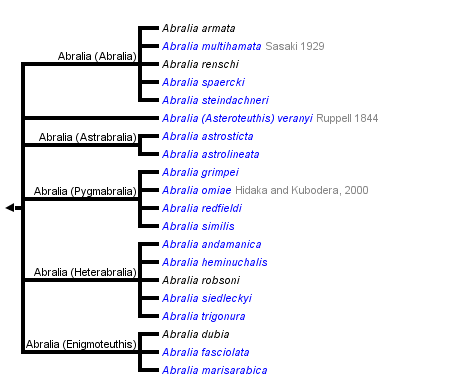


This tree diagram shows the relationships between several groups of organisms.
The root of the current tree connects the organisms featured in this tree to their containing group and the rest of the Tree of Life. The basal branching point in the tree represents the ancestor of the other groups in the tree. This ancestor diversified over time into several descendent subgroups, which are represented as internal nodes and terminal taxa to the right.

You can click on the root to travel down the Tree of Life all the way to the root of all Life, and you can click on the names of descendent subgroups to travel up the Tree of Life all the way to individual species.
For more information on ToL tree formatting, please see Interpreting the Tree or Classification. To learn more about phylogenetic trees, please visit our Phylogenetic Biology pages.
close boxIntroduction
Species of Abralia are small squid some of which are associated with shallow bottoms on steep slopes and as such are members of the mesopelagic-boundary fauna.
Brief diagnosis:
An enoploteuthid ...
- without large, black photophores at the tips of arms IV (see, however, A. astrolineata).
- with fins extending to posterior tip of tail.
 Click on an image to view larger version & data in a new window
Click on an image to view larger version & data in a new window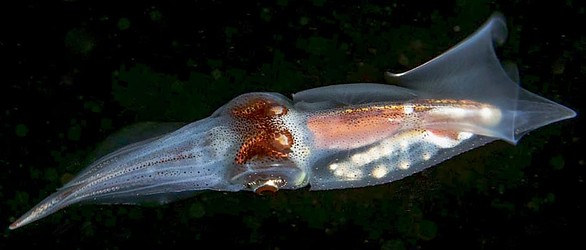
Figure. Abralia trigonura. Same squid as in title image. Note the slender extension of the fin to the tip of the tail. Photographed in situ by Jeffrey Milisen
Characteristics
- Arms
- Arm suckers present distally on Arms IV.
- Arm suckers present distally on Arms IV.
- Tentacles
- Manus of club with one series of hooks; two series of suckers.
- Manus of club with one series of hooks; two series of suckers.
- Buccal crown
- Typical chromatophores on oral surfaces of buccal crown.
- Typical chromatophores on oral surfaces of buccal crown.
- Photophores
- Enlarged photophores on tips of arms IV generally absent; if present, not covered by black chromatophores (exception in A. astrolineata).
- Five to twelve photophores on each eye.
- Complex photophores of integument without red-colored filters.
- Spermatangia receptacles
- Located under dorsal collar, in median pocket at posterior end of nuchal cartilage, or under gladius between stellate ganglia.
- Located under dorsal collar, in median pocket at posterior end of nuchal cartilage, or under gladius between stellate ganglia.
Comments

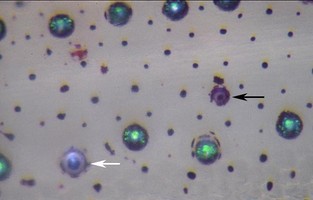
Figure. Ventral view of arm IV integumental photophores of A. trigonura, off Hawaii. Photograph by R. Young.
In life, the integumental photophores have a characteristic appearance. The photo shows the three types of integumental photophores. A "lensed" photophore (white arrow) has a blue color and white ring. A "simple" photophore (black arraow) is small and violet-colored. The remaining are "complex" photophores and have a central green color and small "satellite" green-color points. Often complex photophores will appear blue rather than green depending on their physiological state (see Young and Arnold, 1982). The black dots are chromatophores.
The structure of a complex photophore can be seen here.
Classification
Species of Abralia are generally placed into six subgenera but these may not all be natural groups. The following table (modified from Tsuchiya and Okutani, 1988, and Tsuchiya, 1991) shows the primary taxonomic features of each group.
| Abralia (Abralia) | Abralia (Asteroteuthis) | Abalia (Astrabralia) | Abralia (Pygmabralia) | Abralia (Heterabralia) | Abralia (Enigmoteuthis) | |
| No. sucker series at distal end of sucker series on arms I-III | 3-4 | 3-4 | 2 | 2 | 2 | 2 |
| Which arm IV hectocotylized | Right | Left | Right | Right | Left | Right |
| No. Club hooks | 5-7 | 3-5 | <5 | 1-3 | 2-3 | >5 |
| No. of types of ocular photophores* | 2 | 2 | 1 | 1 | 2 | 1 |
| Large, unpigmented caudal and arm IV-tip photophores | No | No | Yes | No | No | No |
| Attachment of buccal connective to arm III | Ventral | Ventral | Ventral | Ventral | Ventral | Dorsal |
References
Nesis, K. N. 1982. Abridged key to the cephalopod mollusks of the world's ocean. 385,ii pp. Light and Food Industry Publishing House, Moscow. (In Russian.). Translated into English by B. S. Levitov, ed. by L. A. Burgess (1987), Cephalopods of the world. T. F. H. Publications, Neptune City, NJ, 351pp.
Tsuchiya, K. 1991. Abralia fasciolata, a new species of enoploteuthid squid from the western Indian Ocean (Cephalopoda: Oegopsida). Bulletin of the National Science Museum, (series A) 17(2):69-79, 16 figures.
Tsuchiya, K. and T. Okutani. 1988. Subgenera of Enoploteuthis, Abralia and Abraliopsis of the squid family Enoploteuthidae (Cephalopoda, Oegopsida). Bulletin of the National Science Museum, Tokyo (series A) 14: 119-136.
Young, R. E. and J. M. Arnold. 1982. The functional morphology of a ventral photophore from the mesopelagic squid, Abralia trigonura. Malacologia 23: 135-183.
Young, R. E., L. A. Burgess, C. F. E. Roper, M. J. Sweeney and S. J. Stephen. 1998. Classification of the Enoploteuthidae, Pyroteuthidae and Ancistrocheiridae. Smithsonian Contr. to Zoology, No. 586.
Title Illustrations

| Scientific Name | Abralia trigonura |
|---|---|
| Location | Off Kona coast of Hawaii Island. This is the same locality and species, but different date, as the squid in the title photograph of the Enoploteuthidae page. |
| Specimen Condition | Live Specimen |
| Identified By | J. Milisen, R. E. Young |
| Behavior | Squid swimming close to ocean floor at night at a depth of about 25 m, attracted by photographer's lights. |
| Sex | Male |
| Life Cycle Stage | Mature |
| Size | 35 mm ML (guess) |
| Copyright | © 2018 Jeffrey Milisen |
About This Page

University of Hawaii, Honolulu, HI, USA

Tokyo University of Fisheries, Tokyo, Japan
Page copyright © 2018 and
 Page: Tree of Life
Abralia .
Authored by
Richard E. Young and Kotaro Tsuchiya.
The TEXT of this page is licensed under the
Creative Commons Attribution-NonCommercial License - Version 3.0. Note that images and other media
featured on this page are each governed by their own license, and they may or may not be available
for reuse. Click on an image or a media link to access the media data window, which provides the
relevant licensing information. For the general terms and conditions of ToL material reuse and
redistribution, please see the Tree of Life Copyright
Policies.
Page: Tree of Life
Abralia .
Authored by
Richard E. Young and Kotaro Tsuchiya.
The TEXT of this page is licensed under the
Creative Commons Attribution-NonCommercial License - Version 3.0. Note that images and other media
featured on this page are each governed by their own license, and they may or may not be available
for reuse. Click on an image or a media link to access the media data window, which provides the
relevant licensing information. For the general terms and conditions of ToL material reuse and
redistribution, please see the Tree of Life Copyright
Policies.
- Content changed 29 March 2018
Citing this page:
Young, Richard E. and Kotaro Tsuchiya. 2018. Abralia . Version 29 March 2018 (under construction). http://tolweb.org/Abralia/19642/2018.03.29 in The Tree of Life Web Project, http://tolweb.org/




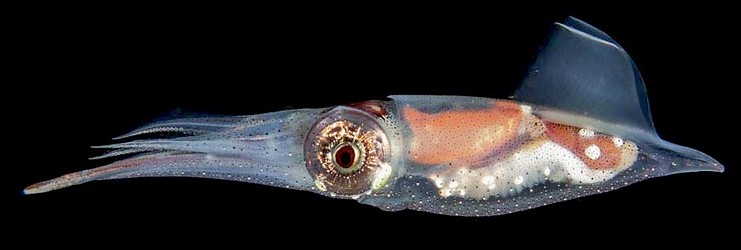
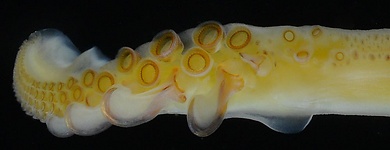
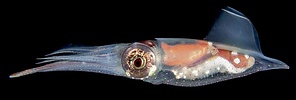

 Go to quick links
Go to quick search
Go to navigation for this section of the ToL site
Go to detailed links for the ToL site
Go to quick links
Go to quick search
Go to navigation for this section of the ToL site
Go to detailed links for the ToL site